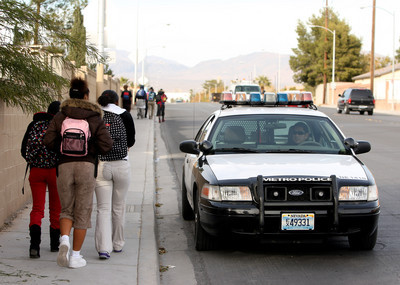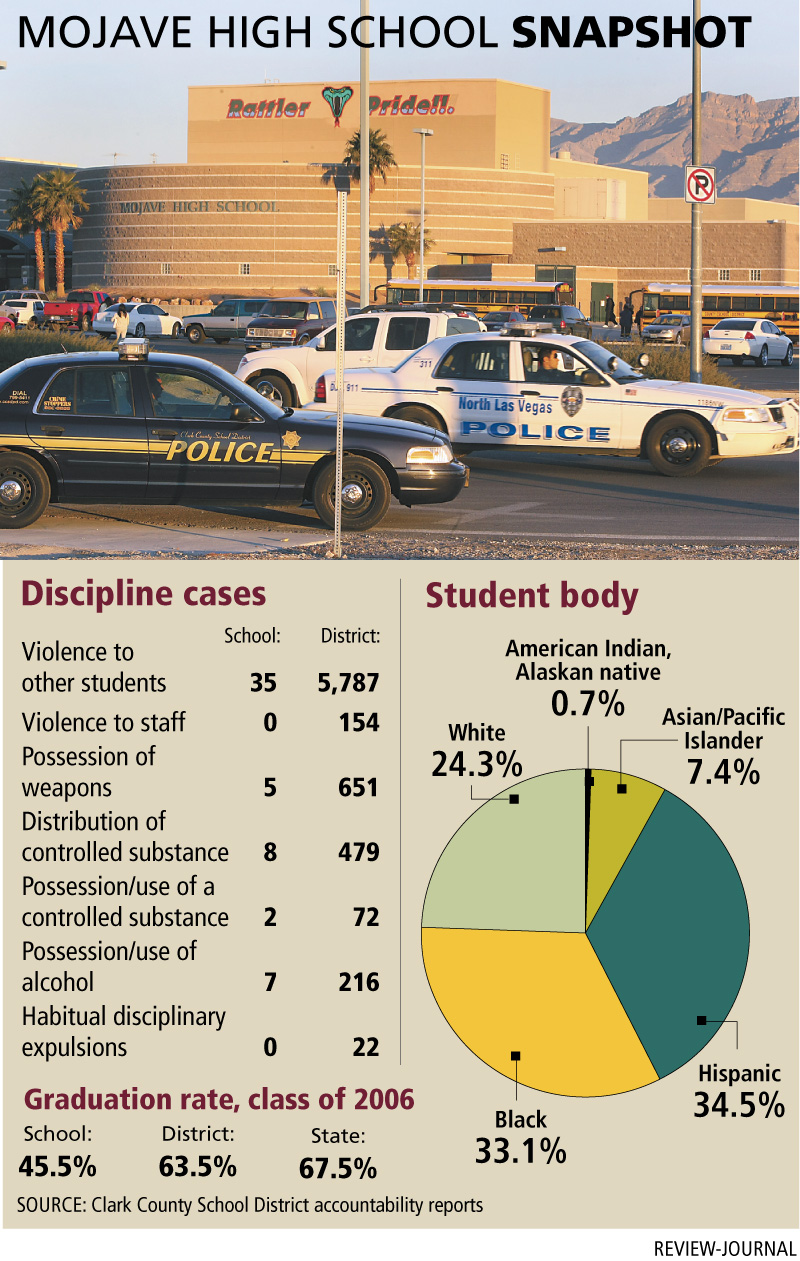One suspect arrested in shootings at bus stop
Authorities arrested a suspect Wednesday night in connection with the previous day's shooting of six young people near a school bus stop.
Las Vegas police Capt. Kirk Primas said a tip came in late Tuesday night that the suspect was going to Chicago on a Greyhound bus. U.S. marshals and Denver police SWAT team members were waiting for the bus when it stopped at a bus station in Denver about 9:30 p.m. Pacific time.
Nicco Tatum, 18, is to be charged with six counts of attempted murder with a deadly weapon and six counts of battery with a deadly weapon, Primas said.
Earlier in the day, police had narrowed their investigation and campuses had stepped up security following one of the worst episodes of school-related violence in local history.
Sheriff Doug Gillespie said the search for the second person who fired shots at the bus stop will remain a top priority.
"I think we need to send a clear message to these people, these thugs," Gillespie said. "We're going to catch them, we're going to prosecute them, and we're going to send them to prison."
Four of the people wounded are Mojave High School students. Detectives have ruled out any connection to a fight earlier Tuesday at Mojave High School in North Las Vegas and say they now believe the shooting was related to a fight Monday at the bus stop near Alexander and Walnut roads, he said.
Investigators weren't sure what led up to that fight, he said.
"People have talked about the gang theory. People have talked about the girlfriend theory, but at this point that hasn't been confirmed," Gillespie said Wednesday afternoon.
Investigators believe the incident could involve gang members because of a "gang-related verbal altercation" on the campus, according to an internal memo from Clark County School District Superintendent Walt Rulffes.
Some students believe the shooting stemmed from racial tensions.
"The shooting wasn't gang-related. It was a racial thing that got out of hand," said Mojave junior Jonathan Holmes, who is black.
Holmes said a friend who witnessed the incident told him that a large group of Hispanics and a smaller group of blacks approached each other just before the gunfire.
"The blacks felt the need to defend themselves," he said.
Tatum is black, Primas said, but police have no solid evidence that the shooting was racially motivated. Gillespie identified the gunmen as black and Hispanic males.
"It's hard to say who they were shooting at and who they weren't," Gillespie said.
Four of the victims, ranging in age from 14 to 20, were treated and released from University Medical Center. Two others remained hospitalized. Mark Smith, 17, who was shot in the belly, was in stable condition, and Alex Rios, 18, who also suffered a torso wound, was upgraded to serious condition Wednesday.
Students at the bus stop Wednesday morning were met with more than a half-dozen police cars either parked at the intersection or cruising nearby streets. At Mojave, orange blockades and school district police cars controlled access to the parking lot as students braved the morning chill and safety fears at the campus.
"The only reason I'm here is that I've got to learn," said Donovan, a freshman who declined to give his last name.
He said he didn't feel safe at the school, but not just because of Tuesday's shooting. He feels threatened every time somebody tries to sell him drugs, something that's happened to him on campus four times since school started, he said.
"They just walk up and say, 'Do you wanna buy some crack?'" Donovan said, his hands tucked into his sweat shirt.
"To be honest, this is a crack-head school."
Tanner, a freshman girl, nodded her head as Donovan spoke. She said she came to school to avoid the absence on her record.
When asked what would make them feel safer at school, they looked at each other and then at the parking lot, where police cars anchored the entrances.
"More than this amount of cops," Donovan said.
"Yeah," Tanner agreed.
Sophomore Daniel Jones shared those worries as he headed home Wednesday. He said two school police officers tried to stop and search students heading into the school, but they were outnumbered by hundreds of students, most of whom walked in without being stopped.
"They're trying to keep it safe, but it could be a lot better," the 15-year-old said. "They could have stopped everybody and checked all the bags for weapons."
Other students said the overwhelming police presence made them uneasy.
"It was freaky today, loud and full of police," said Zoren Co, a 16-year-old junior.
Elizabeth Castro, who picks up her 15-year-old daughter at Mojave every day, said she was shocked by the shooting and wished the school had informed the parents about ongoing gang violence at the school.
"They need to have more control over the gangs. It's obvious they don't have control," she said in Spanish while her daughter, Michelle, translated.
Mojave is a struggling school at which less than half of the seniors graduated last school year. The school of about 2,200 students also had the second-highest number of violence-related suspensions and expulsions in the district's northeast region.
The neighborhood around the bus stop is filled with well-kept stucco homes with values topping $200,000, but gang graffiti is not an uncommon sight.
Rulffes said he had hoped never to have a mass shooting involving students on his watch. But now that it has happened, he said the district and the community need to work to improve conditions for children at school and between home and school.
"I certainly don't want parents to have undue alarm," Rulffes said. "But they have to be aware of safety issues affecting students."
In a Wednesday memo sent to district staff, Rulffes reminded everyone that vigilance is key in protecting students. As superintendent, Rulffes said, he plans to continue the partnership forged with local law enforcement after an earlier school bus shooting. That partnership made responding to Tuesday's crisis more seamless, though Rulffes said there was an internal breakdown in communication that resulted in conflicting reports and mixed messages.
Canyon Springs High School Principal Ronan Matthew, who dealt with a school bus shooting last year, said district policymakers have not paid enough attention to staff and student safety.
When one of his students was shot in the leg after stepping off a bus, Matthew launched an unsuccessful attempt to install metal detectors at his school, which is about two miles south of Mojave. The request got bogged down in bureaucracy and was rejected by district officials who said metal detectors were an overreaction, he said.
"They aren't the ones dealing with the issues every day," Matthew said. "They aren't the ones who have to take guns off of kids."
Rulffes pointed out that metal detectors wouldn't have prevented Tuesday's shooting, which happened about four miles from campus.
Ken Trump, president of National School Safety and Security Services, an Ohio-based consulting and research firm, said gang activity follows a general pattern when it unfolds in a school setting. It usually starts with an argument over a girlfriend or a perceived insult and leads to a fight that is broken up by school staff.
The real high-risk situations take place after school when students are free to escalate the violence.
The key, Trump said, is naming the problem. School officials too often shy away from labeling incidents what they are. If they're gang-related or racial, say so, Trump said.
"These are tough situations to manage," he said. "If you aren't well-prepared to respond to them, you're going to find yourself answering tough questions the next day from parents, the media and the broader community."
As recent Las Vegas events have shown, school shootings no longer can be treated as isolated incidents, he said. The community needs to accept responsibility for them, and decision-makers need to agree that it doesn't matter where they take place.
"The focus can't be what side of the property line kids were shot on, but that kids were shot," he said.
Review-Journal staff writer Antonio Planas contributed to this report. Contact reporter Brian Haynes at bhaynes@reviewjournal.com or (702) 383-0281.
BUS STOP SHOOTING LETTERS RELATED STORY: Victim's dad says he's proud of his son


















